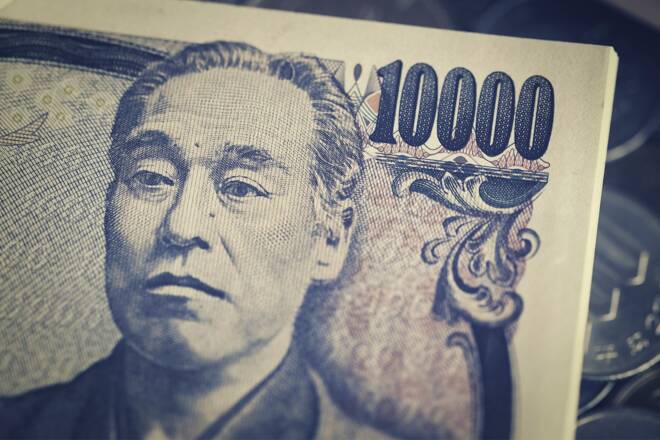Advertisement
Advertisement
Japanese Yen and Aussie Dollar News: USD/JPY Eyes 152.5 if Japan’s Tool Orders Surge
By:
Key Points:
- Stronger-than-expected machine tool data may attract USD/JPY buyers, testing support near the 152.5 level.
- Japanese firms report mixed feelings on Yen depreciation; businesses support stability over volatility.
- AUD/USD could face further pressure from weaker consumer confidence data.
Will Japan’s Machine Tool Orders Shift USD/JPY Trends?
Japan’s machine tool orders report, due Tuesday, November 12, will likely influence USD/JPY demand trends. Economists forecast machine tool orders to fall 3.7% year-on-year in October, an improvement from the 6.5% decline in September.
Better-than-expected figures could signal rising demand. Improving demand would coincide with the Japanese Yen’s recent weakening, supporting overseas appetite for Japanese goods.
Upbeat orders may drag the USD/JPY toward 152.5, a critical support level, on expectations of improving labor market conditions and private consumption. Conversely, a more marked decline in orders could delay a Bank of Japan rate hike, potentially driving the USD/JPY toward 155.
Japanese Firms, Consumer Sentiment, and Yen Depreciation
The Bank of Japan’s Summary of Opinions highlighted views of Yen depreciation on Japanese firms and households, stating,
“There have been a significant number of reports from corporate executives of small and medium-sized firms that they welcome the retracement of the yen’s depreciation and that foreign exchange rates have a larger impact on business management than interest rates. Moreover, various survey results seem to suggest that households also welcome the yen’s retracement.”
Rising demand may boost job creation, wage increases, and consumer spending, possibly pushing inflation higher.
However, the Summary of Opinions contrasted with the BoJ’s previous concerns over Yen depreciation regarding import costs and household expenses.
In June, BoJ Deputy Governor Ryozo Himino discussed the adverse effects of a weaker Yen on Japan’s economy, saying,
“Exchange-rate fluctuations affect economic activity in various ways. It also affects inflation in a broad-based and sustained way, beyond the direct impact on import prices.”
The contrasting statement created uncertainty about the BoJ rate path, impacting Yen demand on Monday.
Japanese Yen Daily Chart
Turning to the US dollar, US inflation expectations also require consideration. Softer inflation expectations could boost bets on a December Fed rate cut, pulling the USD/JPY toward 152.5
Conversely, higher-than-expected inflation may signal a December Fed hold on rates, potentially driving the USD/JPY toward 155.
Additionally, FOMC member insights into the US economy, inflation, and the Fed rate path will influence USD/JPY trends.
AUD/USD and Consumer Sentiment
Aussie consumer confidence figures will draw interest as our focus shifts to the AUD/USD. Economists forecast the Westpac Consumer Confidence Index to drop from 89.8 in October to 89.5 in November.
Weaker consumer confidence may indicate lower consumer spending, dampening inflationary pressures. A softer inflation outlook might raise expectations for a December RBA rate cut, supporting an AUD/USD drop below $0.65500.
Conversely, an unexpected rise in confidence could signal stronger consumer spending, potentially delaying an RBA rate cut until Q1 2025. A less dovish RBA rate path may push the AUD/USD toward $0.67.
Other stats include business confidence figures, which will likely play second fiddle to the Westpac survey-based data.
Australian Dollar Daily Chart
In the US session, consumer inflation expectations will draw interest ahead of Wednesday’s CPI Report. Lower consumer inflation expectations could increase speculation of a December Fed rate cut, supporting an AUD/USD move toward $0.67.
Conversely, an unexpected rise in inflation expectations may dampen prospects for a Fed rate cut, potentially dragging the AUD/USD down to $0.65500.
However, with inflation in the spotlight this week, investors should track FOMC member commentary. Support for delaying rate cuts until Q1 2025 would likely boost US dollar demand, pushing the AUD/USD toward $0.65500.
Traders should stay attuned to live data and central bank commentary. Follow our real-time alerts for market-moving data releases.
About the Author
Bob Masonauthor
With over 28 years of experience in the financial industry, Bob has worked with various global rating agencies and multinational banks. Currently he is covering currencies, commodities, alternative asset classes and global equities, focusing mostly on European and Asian markets.
Did you find this article useful?
Latest news and analysis
Advertisement
